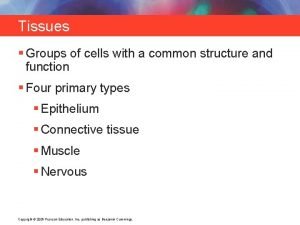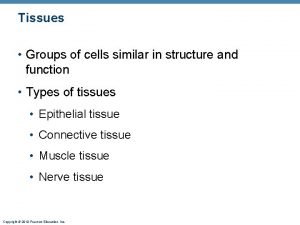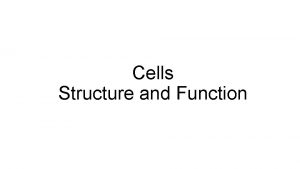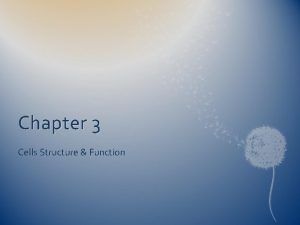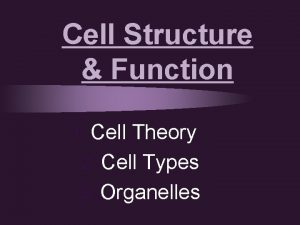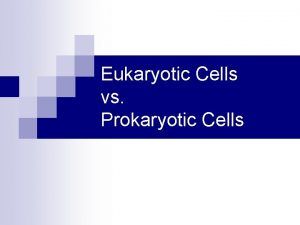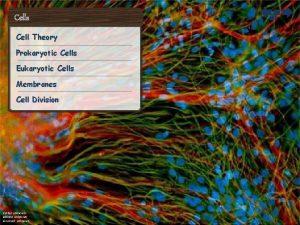Structure Function of Cells Cell Theory The cell












- Slides: 12

Structure & Function of Cells

Cell Theory The cell is the basic unit of living things All organisms are made of cells Cells come only from other cells

Microscopes: Visualizing Cells Compound Light Microscope First compound microscope made by Hans & Zacharias Janssen (circa 1595) Objective lens Eyepiece

Microscopes: Visualizing Cells

Microscopes: Visualizing Cells Resolving power is the most important factor of a microscope’s ability to view small objects Limited by diffraction Lower diffraction = higher resolution

Microscopes: Visualizing Cells Adding an oil immersion to light microscopes resolves objects 0. 2 μm

Microscopes: Visualizing Cells Transmission Electron Microscope (TEM) Oil immersion resolves objects to 0. 0002 μm Can “see” objects 1000 x smaller than light microscope

Microscopes: Visualizing Cells Scanning Electron Microscopes (SEM)

Types of Cells Prokaryotic (bacteria) Eukaryotic (plant & animal) Both can be between 5 and 50 micrometers (µm)

Prokaryotic Cells Have Cell wall (with peptidoglycan, NOT cellulose) Cell membrane Ribosomes Nuclear area w/ circular loop chromosomes (nucleoid) Often have cilia or flagella Mesosome? Lack Membrane-bound organelles True nucleus

Cell Parts and Functions Mesosome (Prokaryotic only) Invaginations of the plasma membrane Exist only during preparation with chemical fixation (for electron microscopy) Damage during chemical fixation?

Eukaryotic Cells Unicellular protists Multicellular Animal Unique structures (centriole, lysosomes, more mitochondria) Plant Unique structures: cell wall (w/ cellulose), large vacuole & plastids Fungi Cell wall made of chitin
 Muscle tissue parts
Muscle tissue parts A group of cells similar in structure and function
A group of cells similar in structure and function A group of cells similar in structure and function
A group of cells similar in structure and function Paranasal sinuses development
Paranasal sinuses development Loop of henle
Loop of henle Parafollicular cells vs follicular cells
Parafollicular cells vs follicular cells Somatic vs gamete
Somatic vs gamete Somatic cells vs germ cells
Somatic cells vs germ cells Chlorocruorin
Chlorocruorin Eukaryotic cells vs prokaryotic cells
Eukaryotic cells vs prokaryotic cells Plant cell and animal cell venn diagram
Plant cell and animal cell venn diagram Prokaryotic cells vs eukaryotic cells
Prokaryotic cells vs eukaryotic cells Why did robert hooke name cells “cells”?
Why did robert hooke name cells “cells”?
